
| JRL Home |
News | Limit Fishing |
Angling Pond |
Lake One |
Party Pond |
Hatchery | Homestead History |
General Information |
Fly Fishing Club |
Events | Recipes | Angler's Gallery |
For the Birds |
Fish Stuff |
Gardens | Bass Pro Shops |
Links |
|
||||
Rainbow Trout
A 3 pound trout can break six pound test quite easily. That's double its body weight. |
Trout can accelerate from a standstill to 23 mph in one second. That's 33 feet of fishing line per second. They can maintain that speed to take 100 yards of fishing line. 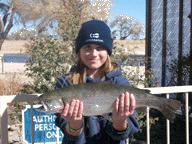
|
|
||
|
Trout Zoological Classification
The Life Stages of Rainbow Trout
Blue Catfish: Ictalurus Furcatus ( "fish cat" "Forked" ) Channel Catfish: Ictalurus Punctatus ( "fish cat" "spotted" ) 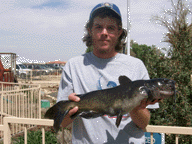
|
(Oncorhychus mykiss) Rainbow trout are native to the western Sierra Nevadas and belong to the family of fish known as salmon. There are more than one hundred varieties of rainbows. Today they are raised in hatcheries around the world. Rainbows are unusual because there are two types that can share the same habitat at the same time, an anadromous form called steelhead, which migrate to the ocean but must return to freshwater to spawn and benthopelagic trout, that stay in fresh water all their lives. They prefer highly oxygenated, cool, clear streams or lakes with temperatures ranging from 55 to 60 degrees fahrenheit but can tolerate slightly higher temperatures. Among their many traits, are a rainbow's small scales, long body and silvery sides with a horizontal pinkish to reddish bandof scales. They also are identified by their 8 to 12 rays in their anal fin, a mouth that doesn't extend pass the back of their eye, and their lack of teeth at the base of the tongue. Steelhead tend to be more silvery than freshwater rainbow and have chrome-colored sides that usually lack the pink stripe. Most hatchery raised rainbows have their adipose fin clipped to distinguish them from wild fish. Jess Ranch Lakes does not clip our hatchery trout. Stream or river rainbows display darker spots and brighter pink stripe coloration. All fish become darker when in spawning condition. Their spots become more prominent and the pink stripe more intense. A male's jaws lengthen and the lower jaw develops a kype or hook like extension. The lifespan and size of a rainbow depends on where they live and what they eat. Rainbows that live in a stream, usually grow to one pound in four years. They can live to eleven years, but most live between four and seven years. Although rainbows are near the top of the food chain in their freshwater habitat, and will eat smaller fish ( up to and over one third of their own body length) from the time they are fry, they will eat most anything, with a diet that consists mostly of insects, larva, crustaceans, eggs, plankton, salmon carcasses and even small mammals. Rainbows that eat a diet high in scuds (freshwater shrimp) and crawdads have flesh that is orange-pink and prized for flavor by anglers. Steelheads and non-migrating rainbows are iteroparous and may spawn several times in their lifetime. Non-migrating trout and Steelhead can interbreed and produce offspring of either type. Because of their adaptability, these fish can live in freshwater or saltwater due to habitat barriers either man made or natural such as dams or drought conditions. In the wild, male and female spawners as young as three to five years old have been seen, but most rainbows mature and spawn at age six or seven years old. Spawning frequency ranges from annually to once every three years and rainbows up to eleven years of age have been seen spawning. Most populations of rainbows spawn in the spring, however, spawning may occur at anytime of the year and takes place in small tributaries or at the inlet or outlet of a lake. The steelhead smolts (juvenile, immature fish) usually remain in freshwater for one to three years before heading to sea, where as salmon, generally go to sea as smolts. They will stay at sea for up to four years before returning to fresh water. Steelheads migrate upriver at different times of the year. Summer-run steelhead migrate between May and October, before they are fully mature. They spawn after they reach their reproductive maturity in the spring. Winter-run steelhead mature fully in the ocean before migrating, between November and April, and spawn shortly after returning to freshwater. A female rainbow will lay between two hundred and eight thousand eggs whereas a walleye of the same weight will lay up to fifty times more eggs per spawn. Life is dangerous in the first stages of of a rainbow's life as fewer than one percent of the fry will survive one year. Only 1 steelhead out of a redd of 1000 eggs will survive to spawn. Recently there have been studies that show that hatchery raised steelhead do not reproduce well in the wild. Perhaps this indicates that rainbows that reproduce must possess a certain genetic toughness associated with natural selection. There is much yet to learn about this remarkable species. 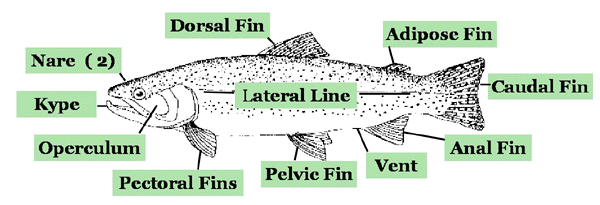
Trout Sense and Physiology Trout have streamlined bodies and fins that allow them to go through the water with little resistance. Their body shape also enables them to conserve energy and face the exhausting task of swimming upstream. They tend to suck up their food rather than engulfing it like bass do and also use their mouths to investigate potential foods. Males will also use their mouths to fight each other during the spawning season. Trout do most of their foraging by sight and their pupils are trangular in shape rather than round like humans, giving them a wider field of vision. The position of their eyes allow them to see well within an area above their heads known as the Snell Circle. This gives them optimum vision where most predators attack. Trout are nearsighted with fair vision up to twenty feet depending on water clarity. Rainbow trout see color well. They see red and blue wavelengths much the same as humans but perceive yellow and greens better than we do since yellow and blue wavelengths travel better in water than air. Recently scientists have found that trout can also see ultraviolet (UVA) wavelengths. Trout have a three chamber internal ear that uses calcified stone instead of the fluid that humans have in their internal ears. This organ allows them to tell up from down and left from right. They have two nares (basically a fish nose), which are closed sacs that transmit chemical signals to the brain, allow them to smell and can detect some chemicals on human hands at 1 part per 80 billion-- that's 1/2 teaspoon in an Olympic pool. Trout also use smell to communicate with each other. Females use chemicals called pheromones in the mucus of their skin to tell males when they are ready to spawn. Also trout seem to use their sense of smell to help locate their original spawning streams. Overall water transmits chemicals much better than air. Something that you cannot smell in the air is stronger in the water. The gills act much like lungs with large surface areas that exchange oxygen for carbon dioxide produced as waste by cells. Trout open their mouths wide to allow water to pass through their gills. Lake trout also use their gills to collect zooplankton. Gill rakers pick food off the gills so the trout can swallow them. Gills are delicate and are covered by a hard protective plate called the operculum. A swim bladder, a long skinny air filled sac, allows them to maintain a certain level in the water without much effort. The Lateral Line (specialized scales) is a unique sense organ that runs from the operculum to the tail and gives the fish a "distant touch" sensitivity that detects pressure waves or vibrations. This allows the fish to swim in a school without bumping into other fish. The Lateral Line is made up of special cells called neuromasts. How To Fillet a Trout 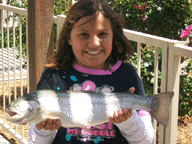
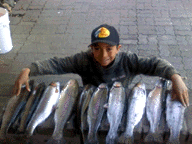
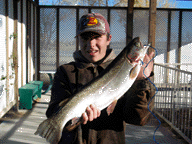
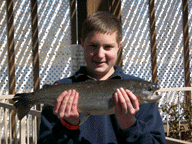
|
|||
A Bluegill's Life 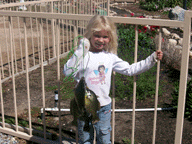 |
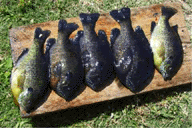 |
|||
How To Clean A Trout  All you need is a small knife and a spoon. |
||||
| Gills act as the lungs of a fish. Gillrakers allow the fish to strain food from the water flowing through their gills. The operculum is the protective plate that shields the gills. When handling any fish you should be especially careful not to injure this area if you wish to release or keep the fish alive. | ||||
|
Ecology of A Lake Limnetic Zone open water-light doesn't penetrate to the bottom. Littoral Zone near shore- light penetrates to the sediment- allows aquatic plants to grow. Euphotic Zone surface to where light is too low for plants to grow. Benthic Zone bottom sediment -usually rich in invertebrates such as insect larvae, or small crustaceans. Organic content of the bottom affects the productivity as does the physical characteristics of the lake floor. Sandy sediment is unstable for plant species, has little organic matter( food for organisms) and offers poor protection from predators. Rocky bottoms can offer protection from predators, good areas for attached algae and other organic ooze (food). A flat bottom with mucky sediment provides good food for benthic organisms but provides less protection unless higher plants are present. Lake organisms that go where they choose fish, amphibians, turtles. larger zooplankton and insects. Lake Organisms that go where the water takes them zooplankton (animals), (plants)phytoplankton, bacterioplankton (bacteria), Detritus ( dead stuff- produced within lake and washed in from watershed). Lake organisms that live on the bottom (benthos) aquatic insects, clams, snail, worms crayfish, higher plants ( macrophytes) and attached algae (perphyton), bacteria and fungi. |
The Bass Life Species: Micropterus salmoides Largemouth bass grow to 4 to 6 inches during their first year, 8 to 12 inches in two years,and to 16 inches in three years. They are usually green with dark blotches that form a horizontal stripe along the middle of the fish on either side. The underside ranges in color from light green to almost white. They have a nearly split dorsal fin with the anterior portion containing nine spines and the posterior portion containing 12 to 13 soft rays. Their upper jaw reaches far beyond the rear margin of the eye. 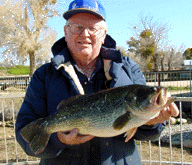
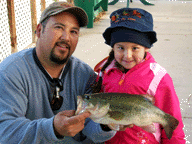
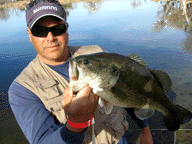
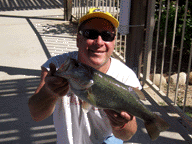
|
|||
Al Schneider's Homemade Killer Trout Bait Concoction In a non-stick saucepan melt the power bait, velveeta & marshmallows. Remove from heat and add salmon eggs, smashing them a bit, then add syrup and attractant. Let the mixture cool and then need like dough. Put in container and refrigerate. When fishing the bait, roll a small bait sized ball in your hands. Slide the bait ball down your 3" to 4" leader and place on treble hook. Use any type of sinker set-up. In June 2007, a 43 Lbs 6 ozs rainbow was caught by Adam Konrad of Saskatoon, out of Lake Diefenbaker in Canada. The fish was 38.5 inches long and had a 33 inch girth. |
Thanks to Kevin for putting this list together. For Trout, Catfish, Bluegill or Bass
|
|||
|
|
|
|
|
|
|
||||||
|
|
|
|
|
|
|
||||||
|
|
|
|
|
|
|
copyright © 2006-2020